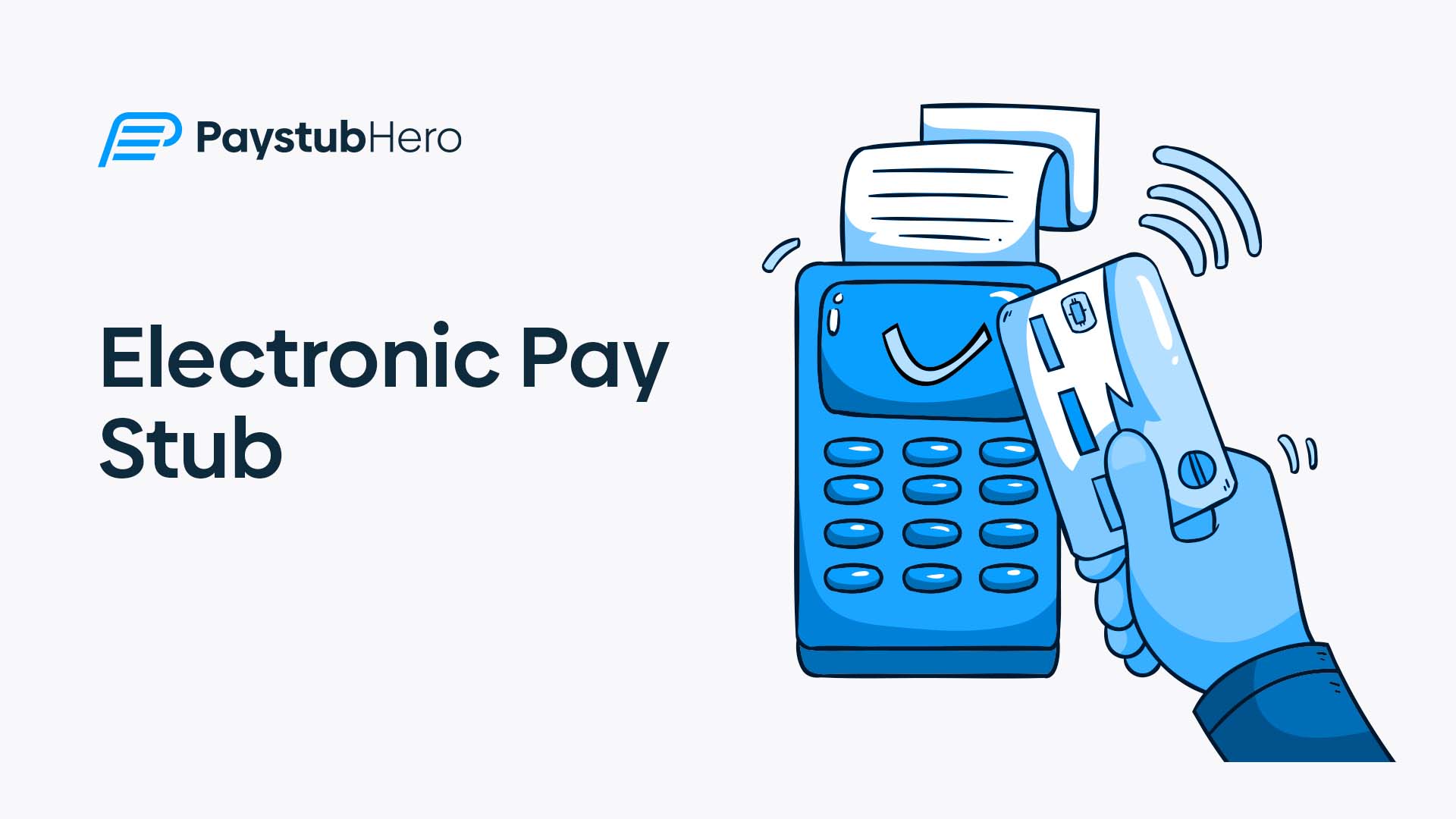Electronic pay stubs, or e-pay stubs, have revolutionized the way employees access and manage their financial information. Imagine living in a world where all your payroll processes are managed digitally, eliminating the paper clutter, ensuring heightened security, and providing instant access to important documents anytime, anywhere.
Welcome to the world of the electronic pay stub, the future of efficient, effective, and eco-friendly payroll management.
The shift from physical documentation to digital formats has been substantial in recent years, particularly in the realm of payroll. The electronic pay stub has emerged as a key player in this digital revolution, significantly enhancing the process of wage disbursement and income verification.
Designed to provide a comprehensive breakdown of an employee’s earnings, the electronic pay stub is not just a digital equivalent of a paper pay stub. It represents an evolutionary leap in payroll management, offering a plethora of benefits to both employers and employees.
Simplicity, accuracy, convenience, and environmental sustainability are just a few factors that have fueled the rise of electronic pay stubs. This article will delve into what an electronic pay stub is, explore the key differences between pay slips, pay cheques, and pay stubs, and highlight the undeniable benefits of transitioning to digital pay documentation.
We will also touch upon how to create electronic pay stubs and the role of direct deposit in today’s payroll landscape.
So, is an electronic pay stub the straightforward answer to efficient payroll management that it promises to be? Let’s find out.
Table of Contents
- Introduction: Electronic Pay Stub: The Digital Revolution in Payroll Management
- What is an Electronic Pay Stub? Understanding the Digital Shift in Payroll
- From Pay Cheque to Electronic Pay Stub: Tracing the Evolution in Payroll Management
- Benefits of Electronic Pay Stubs: Revolutionizing Payroll Management One Stub at a Time
- Pay Slip vs Pay Stub, Pay Statement vs Pay Stub: Understanding the Distinctions in Payroll Terminology
- The Evolution of Payroll: Embracing the Direct Deposit Pay Stub
- Conclusion: Is It Time to Embrace the Future with Electronic Pay Stubs?
What is an Electronic Pay Stub? Understanding the Digital Shift in Payroll
An electronic pay stub, also known as a digital or e-pay stub, is a comprehensive digital record of an employee’s wages for a specific pay period. But what does it mean to make this shift from paper to pixel?
In the digital age, where ‘green initiatives’ are on the rise, the electronic pay stub represents a shift in how companies manage and record their payroll activities. This is much more than just an online copy of a physical pay stub. It’s an innovative solution that combines convenience, efficiency, and sustainability.
This document, commonly referred to as pay advice, provides a detailed breakdown of earnings, including gross wages, taxes, deductions, and net pay. It may also include other vital pieces of information such as accrued vacation, overtime, bonuses, and other pertinent details.
Essentially, an electronic pay stub is a window into an employee’s income history, a tool for financial planning and accountability, and a crucial component of transparent employer-employee communication.
It is also an essential resource for tax preparation and income verification, particularly for freelancers and independent contractors who need to manage these tasks independently.
From Pay Cheque to Electronic Pay Stub: Tracing the Evolution in Payroll Management
There was a time when the pay cheque was king. Employees would eagerly await their paper pay cheque, a physical testament to their hard work and effort. But as technology has advanced and digitization has permeated our lives, this traditional method of payment is being replaced by more efficient, secure, and convenient systems, the most prominent of which is the electronic pay stub.
The shift from pay cheque to electronic pay stub represents a significant transformation in the field of payroll management.
This transition is not just about moving from paper to digital formats; it’s about fundamentally changing how employers distribute wages and how employees receive and understand their earnings.
So, why has this shift occurred, and what makes electronic pay stubs preferable over the classic pay cheque? The reasons are manifold and are rooted in the broader trends towards digitalization, efficiency, and sustainability.
The cost savings, increased accuracy, enhanced security, and the environmental benefits of electronic pay stubs have made them a preferred choice for businesses of all sizes.
Moreover, the advent of electronic pay stubs has also brought about other significant changes in payroll practices, most notably the rise of direct deposit. This method, which involves transferring wages directly into an employee’s bank account, has been steadily gaining traction due to its speed, efficiency, and convenience.
In essence, the shift from pay cheque to electronic pay stub reflects a broader move towards digitization across all areas of business operations.
It’s an evolution that embodies the best of technological advancement, making payroll management more streamlined, efficient, and user-friendly than ever before.
Benefits of Electronic Pay Stubs: Revolutionizing Payroll Management One Stub at a Time
In the digital era, the electronic pay stub is much more than just a paperless version of a traditional pay stub. It is a fundamental tool in the evolution of payroll management, one that provides a host of benefits for businesses and employees alike.
Let’s delve deeper into these benefits and see why electronic pay stubs are increasingly becoming the norm in today’s corporate landscape.
1. Increased Accuracy:
Precision is paramount in payroll management, and this is where electronic pay stubs excel. By automating the process, these digital tools minimize the risk of human error, ensuring each pay stub is accurate down to the last cent.
Payroll software, like Paystubhero, facilitates automatic calculations based on the information entered, virtually eliminating errors and discrepancies that can cause financial and administrative headaches.
2. Easy Access and Storage:
Gone are the days when you needed physical file cabinets for storing piles of paper pay stubs. Electronic pay stubs can be stored securely in the cloud and accessed anytime, anywhere, from any device with an internet connection.
This digital storage solution not only saves space but also simplifies retrieval, making it easier than ever for employees to review their pay information or provide proof of income when required.
3. Enhanced Security:
Data security is a top concern in today’s digital age, and electronic pay stubs offer an additional layer of protection compared to their paper counterparts. They are typically password-protected and stored on secure servers, reducing the risk of sensitive information falling into the wrong hands.
In a world where identity theft is a real threat, the enhanced security of electronic pay stubs provides much-needed peace of mind.
4. Environmentally Friendly:
Sustainability is not just a buzzword anymore; it’s a business imperative. By switching from paper pay stubs to electronic versions, companies can significantly reduce their environmental impact.
It’s a simple yet effective way to contribute to sustainability goals, fostering a greener image that resonates with employees, customers, and stakeholders alike.
The advent of electronic pay stubs signifies an important leap forward in payroll management, offering enhanced accuracy, convenience, security, and sustainability. Whether you’re a small business owner, an entrepreneur, or an independent contractor, these benefits make a compelling case for making the digital shift.
Pay Slip vs Pay Stub, Pay Statement vs Pay Stub: Understanding the Distinctions in Payroll Terminology
In the realm of payroll management, words like pay slip, pay stub, and pay statement are often thrown around interchangeably. However, to fully appreciate the revolution that the electronic pay stub represents, it’s essential to understand the nuances and distinct attributes of each of these terms.
So, let’s dive into the differences and dispel any confusion.
Pay Slip: Traditionally, a pay slip has been a document accompanying a pay cheque. This document outlines the details of an employee’s earnings for a specific period, along with the deductions taken out.
Essentially, it’s a record of what makes up the employee’s net pay, including factors like gross salary, taxes, insurance, and other deductions. The pay slip, usually handed out in a paper format, was a staple in the era of physical pay cheques.
Pay Stub: Similar to a pay slip, a pay stub also details an employee’s earnings and deductions for a specific period. However, it’s important to note that pay stubs are often more detailed, offering a comprehensive view of an employee’s financial information.
This can include year-to-date totals, retirement contributions, vacation balances, and more. The pay stub, whether in a physical or electronic format, serves as a crucial financial record for employees.
Pay Statement: A pay statement is a broader term, encapsulating all information regarding an employee’s compensation. This often includes the same information as a pay stub but might also feature additional data, such as accrued vacation time, overtime hours, and benefits information. In essence, a pay statement is a more comprehensive view of an employee’s financial relationship with their employer.
With these distinctions in mind, it’s clear why the electronic pay stub is gaining popularity. It combines the simplicity of a pay slip, the detail of a pay stub, and the comprehensive nature of a pay statement into a single, easy-to-access digital document.
This synergy makes the electronic pay stub a powerful tool for modern payroll management, seamlessly blending convenience, efficiency, and thoroughness.
The Evolution of Payroll: Embracing the Direct Deposit Pay Stub
As the landscape of payroll management continues to evolve, one trend that has significantly impacted the way employers disburse wages and employees receive their earnings is the direct deposit pay stub. It’s a digital innovation that has brought about considerable changes in payroll practices, creating a synergy of speed, security, and convenience.
Let’s delve into what a direct deposit pay stub is and why it represents a significant stride forward in the realm of payroll.
A direct deposit pay stub is essentially an electronic notice that goes hand-in-hand with direct deposit payroll. Direct deposit, as a method of wage disbursement, involves transferring an employee’s earnings directly into their bank account.
This method eliminates the need for paper cheques, providing a quick, reliable, and efficient way of getting paid.
Along with the direct deposit, an electronic pay stub is generated and sent to the employee, either via email or through an online portal. This stub provides a detailed breakdown of the employee’s earnings and deductions for the respective pay period. It carries all the information that a traditional pay stub would, only in a digital format.
According to the American Payroll Association, a whopping 93% of U.S. employees received their salaries through direct deposit in 2020. This fact highlights the popularity and acceptance of this method, which, when combined with electronic pay stubs, greatly streamlines the entire payroll process.
The direct deposit pay stub exemplifies the convergence of speed, accuracy, and convenience. Employees can access their wages faster without worrying about losing or damaging a paper cheque.
Employers, on the other hand, can save on the costs associated with printing and distributing paper cheques. Furthermore, it also aligns with environmental sustainability goals, reducing the demand for paper and thus lessening the overall environmental impact.
The shift towards direct deposit pay stubs is, without a doubt, a testament to how technology continues to revolutionize payroll management, making it faster, more secure, and user-friendly for all.
Conclusion: Is It Time to Embrace the Future with Electronic Pay Stubs?
In this digital era, it’s clear that the future of payroll lies in the world of electronic pay stubs. As we’ve seen throughout this article, the shift from paper-based payroll documentation, like pay cheques and pay slips, to electronic pay stubs represents a transformative leap in payroll management.
The electronic pay stub, with its enhanced accuracy, convenience, security, and eco-friendly nature, offers a multitude of benefits for businesses and employees alike.
Whether you’re an entrepreneur, a freelancer, a small business owner, or an independent contractor, making this digital shift could revolutionize your payroll processes, making them more efficient, effective, and aligned with modern-day trends.
Moreover, the emergence of direct deposit pay stubs, which marry the convenience of electronic pay stubs with the speed and reliability of direct deposit, indicates that the digitization of payroll is not just a passing fad. It’s the way forward.
Therefore, the question isn’t if it’s time to switch to electronic pay stubs, but rather why haven’t you already made the switch? As the world moves towards digital solutions, electronic pay stubs represent an opportunity to stay ahead of the curve, streamline operations, and embrace efficiency.
At Paystubhero, we believe in empowering businesses and individuals to take control of their payroll processes. Our user-friendly, affordable, and efficient online payroll software is designed to make creating electronic pay stubs as easy as 1-2-3.
Just enter your company or employee information, and our software will handle all the calculations. It’s time to become a payroll hero with Paystubhero – where generating your pay stubs is simple, quick, and efficient.
Frequent Asked Questions
1. How do I get my electronic pay stub?
- Typically, your employer will provide a secure online portal where you can access and download your electronic pay stub. If not, consult with your HR department for the specific procedure.
2. What is an electronic pay stub?
- An electronic pay stub is a digital version of a traditional pay stub. It provides a detailed record of your earnings, deductions, and net pay for a specific period.
3. How do I get pay stubs if I have direct deposit?
- If your wages are deposited directly into your bank account, your employer should provide electronic pay stubs. These are often accessible through an online portal or may be sent via email.
4. Can I create a pay stub?
- Yes, with online payroll software like Paystubhero, you can easily create your own pay stub. Enter your company/employee information, and the software will handle the calculations.








